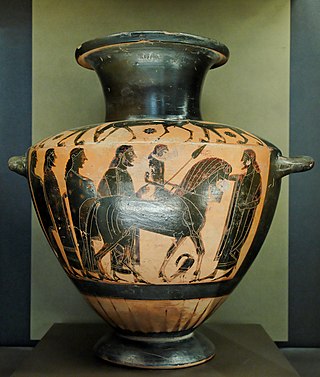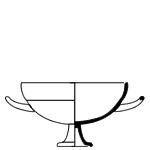
In the pottery of ancient Greece, a kylix is the most common type of cup in the period, usually associated with the drinking of wine. The cup often consists of a rounded base and a thin stem under a basin. The cup is accompanied by two handles on opposite sides.

Black-figure pottery painting, also known as the black-figure style or black-figure ceramic, is one of the styles of painting on antique Greek vases. It was especially common between the 7th and 5th centuries BCE, although there are specimens dating as late as the 2nd century BCE. Stylistically it can be distinguished from the preceding orientalizing period and the subsequent red-figure pottery style.

Kassandra is a Venezuelan telenovela written by Delia Fiallo and produced by RCTV. The story revolves around a young woman, Kassandra who grows up in a traveling circus among many Romani people. She thinks she is connected to the ethnic subgroup not knowing that she is in fact the granddaughter of a rich landowner whose stepson she falls desperately in love with. This love culminates in everyone around Kassandra discovering hidden secrets and her greatly suffering because of it.

Lydos was an Attic vase painter in the black-figure style. Active between about 560 and 540 BC, he was the main representative of the "Lydos Group". His signature, ό Λυδός, ho Lydos, inscribed on two vases, is informative regarding the cultural background of the artist. Either he immigrated to Athens from the Lydian Empire of King Kroisos, or he was born in Athens as the son of Lydian parents. In any case, he learned his trade in Athens.

The Amasis Painter was an ancient Greek vase painter who worked in the black-figure technique. He owes his name to the signature of the potter Amasis, who signed twelve works painted by the same hand. At the time of the exhibition, "The Amasis Painter and His World" (1985), 132 vases had been attributed to this artist.
The Oxford Palmette Class is the name given both to a class of ancient Attic kylikes and to the group of vase painters that made them.

The Ptoon Painter was an ancient Greek vase painter of black-figure style active in Athens in the middle third of the 6th century BC. His real name is unknown.

Burgon Group is the conventional name given to a group of Attic black-figure vase painters active in the middle third of the sixth century BC.

The C Painter was one of the most important Attic black-figure vase painters. His works date to circa 575–550 BC. His conventional name was allocated by the archaeologist John Beazley. The C stands for "Corinthianising", a reference to the strong influence of Corinthian vase painting on the artist. He was successor to the Comast Group and used the relatively old-fashioned range of vessel shapes preferred by that group, including lekanis, tripod kothon and skyphos. In contrast, he also painted quite innovative lekythoi with pronounced shoulders, although the more conservative Deinaeira type was still in use by some workshops at his time. The C Painter was the first Attic vase painter to paint cups without an offset lip, the Merrythought cup.

The Heidelberg Painter was an Attic vase painter of the black-figure style, active between about 575 and 555 BC. He is considered one of the most important painters of Siana cups. Along with the C Painter, he is considered the main representative of his style. Generally, the Heidelberg Painter is regarded as the more accomplished artist of the two, although his work did not reach the same breadth of scope. In contrast to many of his contemporaries, he placed special emphasis on the depiction of human figures, at which he was very adept. His figures are very detailed, but often drawn rather sloppily. His early works resemble those of the Comast Group, the later ones those of the Amasis Painter.

Little-Master cups are a type of Attic black-figure cups, produced around the middle and third quarter of the sixth century BC. Their name is based on their fine small-format decoration. Little-Master cups are later in origin than Siana cups, but both types were produced over a considerable period of time. The Little Masters painted only the small upper frieze above the carination of the cup, at times also the lip or handle areas. It is probably that only few of the painters of Siana cups also painted Little-Master cups. One of the first artists to introduce the Little-Master cup in Athens was Kleitias. The change in decoration went along with a lengthening of the cup foot. The dedicated painters of Little-Master cups rarely painted larger formas, whereas painters primarily specialised in large vases are known to also have painted Little-Master cups. Stylistic comparison between larger and smaller formats of the period remains difficult.

Gordion cups are the earliest form of Attic Little-Master cups. The shape probably flourished around 560 BC. They do not only comprise the earliest, but also the smallest examples of Little-Master cups. The cup lip is covered in black slip and clearly distinguished from the rest of the vessel. The handle zone is decorated with a black stripe near its upper edge, and often a second one near the lower edge. The foot is similar to that of a Siana cup, but more elongated and painted with decorative stripes on the bottom. Also similar to Siana cups, the interior is painted with a circular figural image, framed by a tongue pattern. The similarity to Siana cups is hardly coincidental, as they were the direct predecessors of Little-Master cups.

Kassel cups are a specific type of Attic Little-master cups, produced in Athens around 540 to 520 BC. Kassel cups are quite similar to Band cups, but shallower and usually rather small. The lip and body of the vase are usually decorated with simple band patterns. Normally, there are flame motifs on the lip and rays on the body. Some painters added silhouette-like figures in the handle zone. The decorations suggest a link with Siana cups.

Hermogenes was an Attic potter. He was active in Athens in the mid-6th century BC and belongs to the group known as the Little masters. Hermogenes mainly produced cups (kylikes). Well-known are his band cups with depictions of women's heads on the band. The band skyphos, a specific type of skyphos with decoration resembling that of band cups is named after him. Hermogenes was an innovative potter. For example, similar to the potter Amasis, he made lip cups with feet derived from those of Siana cups.

A Siana cup is a type of Attic cup decorated in the black-figure technique. They are named after one of their find locations, the Necropolis of the ancient city of Siana on Rhodes. During the second quarter of the 6th century BC, Siana cups were the predominant cup shape in Athens. The shape remained popular later and was still being produced in large quantities during the era of the Little-Master cups.
The Xenokles Painter was an Attic vase painter in the black-figure style, active around the middle of the 6th century BC. His real name is unknown. His conventional name is based on the fact that he often painted vases made by the potter Xenokles, with whom he may be identical. In artistic terms, he did not reach the talent of comparable painters, such as the Tleson Painter. Characteristic of his work is his habit of cramming lip cups with figures, comparable to the normal decoration of Siana cups.

The BMN Painter was an Attic vase painter in the black-figure style, active during the third quarter of the 6th century BC.
Siana is a city in Uttar Pradesh, India.
The Boxing Siana Cup, is an Archaic vase that is part of the University Museums at the University of Mississippi. The vase is from the region of Attica and is dated to be around 560 BC – 550 BC. The design style of the vase is Attic black-figure and features a scene on the front and back of the cup and one on the interior. The artist of the vase is considered to be the Sandal Painter.

Alexios and Kassandra are two interconnected fictional characters in Ubisoft's Assassin's Creed video game franchise, first appearing as the player characters of the 2018 video game Assassin's Creed Odyssey. Alexios and Kassandra are portrayed through performance capture by Michael Antonakos and Melissanthi Mahut respectively. Leonidas Castrounis and Maria Syrgiannis respectively voice the two characters as children in flashbacks.















